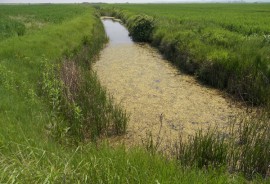The Ecology Consultancy has worked closely with DP World in their development of London Gateway Port and Logistics Park, for the past three years. The development of the site in Essex includes a new deep-water port able to handle the largest containers in the world.
The Task
The creation of the port would involve the reclamation of a significant area of land from the Thames Estuary resulting in the loss of mudflats used by large aggregations of wintering wildfowl. The mudflats lay within the Thames Estuary and Marshes Special Protection Area (SPA), and their loss required compensation through the Conservation of Habitats and Species Regulations (2010).
A new area of mudflat at Site A, adjacent to Stanford Wharf Nature Reserve in Essex, was created through a controlled breach of the sea wall in 2011. Further compensatory mudflats are to be created on an area of land known as Site X, in Cooling Marshes on the north Kent coast, opposite the London Gateway Port. The habitats on Site X were dominated by grazing marsh and its associated ditch systems, with their own wildlife value as a resource for breeding birds, wintering birds and a population of water voles.
The Solution - Mitigation & Habitat Creation
52ha of compensatory mudflat habitat will be created and the site allowed to flood naturally. Any negative ecological impacts of the inundation works are being compensated through habitat creation and enhancement on a neighbouring area of farmland.
Work has already started to prepare for the inundation of Site X with our ecologists working very closely with client and contractors on a rolling mitigation programme to minimise risks to ground nesting birds and mammals, including water vole and brown hare. In consultation with the Bumblebee Conservation Trust we have recommended a bespoke wildflower seed-mix to be sown on the extensive new sea wall as compensation for habitat loss and for the benefit of rare bumblebees and other species.
The Outcome
Working closely with local farmers, DP World engineers and the environment team, as well as liaising with Natural England, The Ecology Consultancy has helped provide detail on the original design, provided a baseline valuation of the habitats to be lost, and assisted on the implementation of mitigation, compensation and enhancement measures. This included arable reversion to wet grassland, the creation of a 1.5ha wader scrape and the creation or restoration of 3.5km of drainage ditches for the benefit of aquatic plants, invertebrates and water voles. Some ditches were left to colonise naturally, whilst others received communities of sedges, rushes and reds transplanted from the ditches that were to be lost at Site X, along with nationally scarce aquatic plants including brackish water crowfoot.
Our ecologists will continue to monitor the ecological health of the new habitats and their wildlife in both Site X and the adjacent compensation land. We hope the new site will eventually become adopted into the boundary of the Marshes Special Protection Area.


 Arboricultural Survey at London Gateway Port, DP World
Arboricultural Survey at London Gateway Port, DP World  Mitigation and enhancement on a major road project, M25 Ponds
Mitigation and enhancement on a major road project, M25 Ponds  SHORT FILM - Creating nature reserves: How DP World London Gateway developed…
SHORT FILM - Creating nature reserves: How DP World London Gateway developed…  Site X: bespoke mitigation and habitat enhancement programme at DP World London…
Site X: bespoke mitigation and habitat enhancement programme at DP World London… 
